Barriers of Institutions in Reusing Waste Materials in Construction Industry
VerifiedAdded on 2023/06/13
|7
|1787
|202
AI Summary
This literature review discusses the hindrances in implementing strategies to reuse waste products in construction industry due to institutions. It also highlights the 5 different levels of waste management strategies and the benefits of waste reduction.
Contribute Materials
Your contribution can guide someone’s learning journey. Share your
documents today.
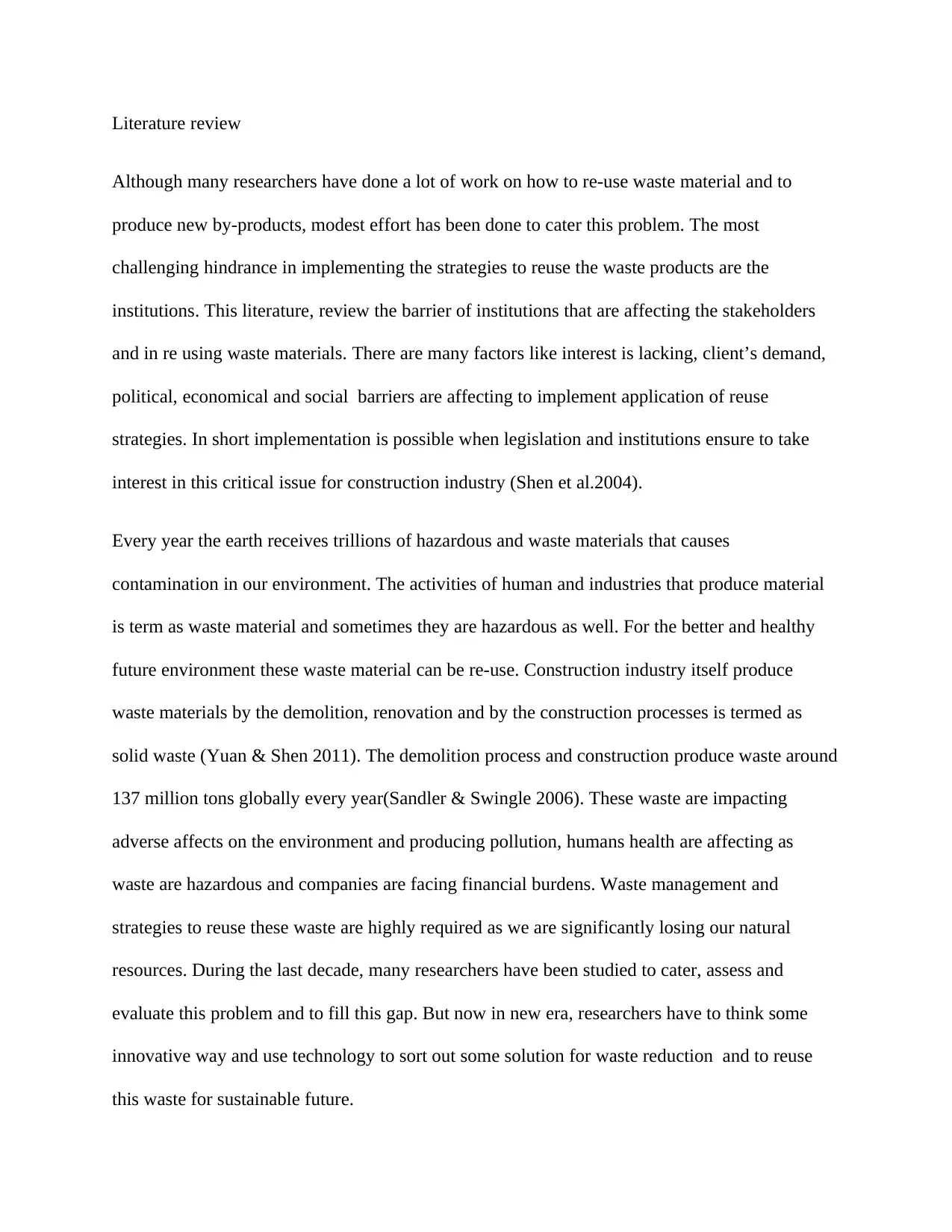
Literature review
Although many researchers have done a lot of work on how to re-use waste material and to
produce new by-products, modest effort has been done to cater this problem. The most
challenging hindrance in implementing the strategies to reuse the waste products are the
institutions. This literature, review the barrier of institutions that are affecting the stakeholders
and in re using waste materials. There are many factors like interest is lacking, client’s demand,
political, economical and social barriers are affecting to implement application of reuse
strategies. In short implementation is possible when legislation and institutions ensure to take
interest in this critical issue for construction industry (Shen et al.2004).
Every year the earth receives trillions of hazardous and waste materials that causes
contamination in our environment. The activities of human and industries that produce material
is term as waste material and sometimes they are hazardous as well. For the better and healthy
future environment these waste material can be re-use. Construction industry itself produce
waste materials by the demolition, renovation and by the construction processes is termed as
solid waste (Yuan & Shen 2011). The demolition process and construction produce waste around
137 million tons globally every year(Sandler & Swingle 2006). These waste are impacting
adverse affects on the environment and producing pollution, humans health are affecting as
waste are hazardous and companies are facing financial burdens. Waste management and
strategies to reuse these waste are highly required as we are significantly losing our natural
resources. During the last decade, many researchers have been studied to cater, assess and
evaluate this problem and to fill this gap. But now in new era, researchers have to think some
innovative way and use technology to sort out some solution for waste reduction and to reuse
this waste for sustainable future.
Although many researchers have done a lot of work on how to re-use waste material and to
produce new by-products, modest effort has been done to cater this problem. The most
challenging hindrance in implementing the strategies to reuse the waste products are the
institutions. This literature, review the barrier of institutions that are affecting the stakeholders
and in re using waste materials. There are many factors like interest is lacking, client’s demand,
political, economical and social barriers are affecting to implement application of reuse
strategies. In short implementation is possible when legislation and institutions ensure to take
interest in this critical issue for construction industry (Shen et al.2004).
Every year the earth receives trillions of hazardous and waste materials that causes
contamination in our environment. The activities of human and industries that produce material
is term as waste material and sometimes they are hazardous as well. For the better and healthy
future environment these waste material can be re-use. Construction industry itself produce
waste materials by the demolition, renovation and by the construction processes is termed as
solid waste (Yuan & Shen 2011). The demolition process and construction produce waste around
137 million tons globally every year(Sandler & Swingle 2006). These waste are impacting
adverse affects on the environment and producing pollution, humans health are affecting as
waste are hazardous and companies are facing financial burdens. Waste management and
strategies to reuse these waste are highly required as we are significantly losing our natural
resources. During the last decade, many researchers have been studied to cater, assess and
evaluate this problem and to fill this gap. But now in new era, researchers have to think some
innovative way and use technology to sort out some solution for waste reduction and to reuse
this waste for sustainable future.
Secure Best Marks with AI Grader
Need help grading? Try our AI Grader for instant feedback on your assignments.
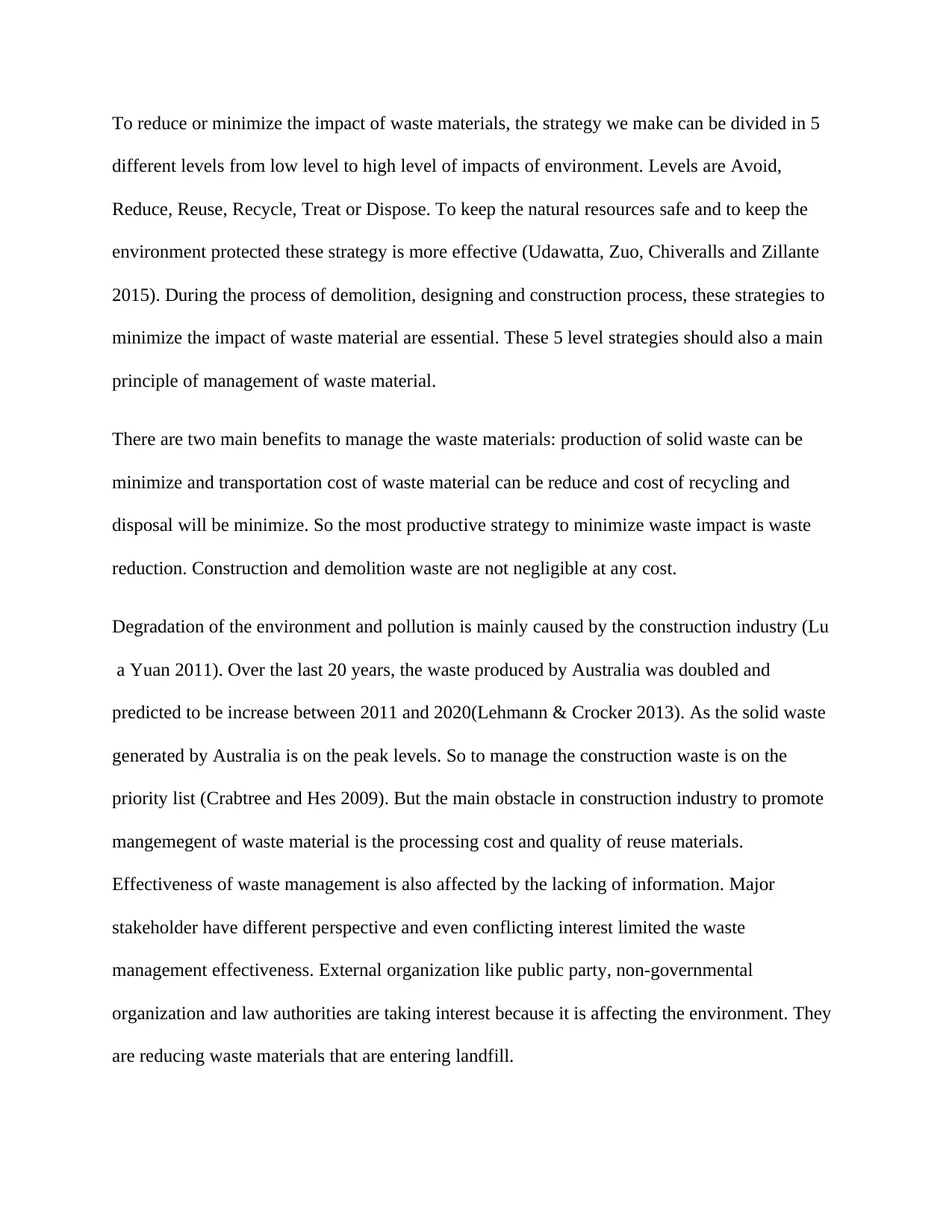
To reduce or minimize the impact of waste materials, the strategy we make can be divided in 5
different levels from low level to high level of impacts of environment. Levels are Avoid,
Reduce, Reuse, Recycle, Treat or Dispose. To keep the natural resources safe and to keep the
environment protected these strategy is more effective (Udawatta, Zuo, Chiveralls and Zillante
2015). During the process of demolition, designing and construction process, these strategies to
minimize the impact of waste material are essential. These 5 level strategies should also a main
principle of management of waste material.
There are two main benefits to manage the waste materials: production of solid waste can be
minimize and transportation cost of waste material can be reduce and cost of recycling and
disposal will be minimize. So the most productive strategy to minimize waste impact is waste
reduction. Construction and demolition waste are not negligible at any cost.
Degradation of the environment and pollution is mainly caused by the construction industry (Lu
a Yuan 2011). Over the last 20 years, the waste produced by Australia was doubled and
predicted to be increase between 2011 and 2020(Lehmann & Crocker 2013). As the solid waste
generated by Australia is on the peak levels. So to manage the construction waste is on the
priority list (Crabtree and Hes 2009). But the main obstacle in construction industry to promote
mangemegent of waste material is the processing cost and quality of reuse materials.
Effectiveness of waste management is also affected by the lacking of information. Major
stakeholder have different perspective and even conflicting interest limited the waste
management effectiveness. External organization like public party, non-governmental
organization and law authorities are taking interest because it is affecting the environment. They
are reducing waste materials that are entering landfill.
different levels from low level to high level of impacts of environment. Levels are Avoid,
Reduce, Reuse, Recycle, Treat or Dispose. To keep the natural resources safe and to keep the
environment protected these strategy is more effective (Udawatta, Zuo, Chiveralls and Zillante
2015). During the process of demolition, designing and construction process, these strategies to
minimize the impact of waste material are essential. These 5 level strategies should also a main
principle of management of waste material.
There are two main benefits to manage the waste materials: production of solid waste can be
minimize and transportation cost of waste material can be reduce and cost of recycling and
disposal will be minimize. So the most productive strategy to minimize waste impact is waste
reduction. Construction and demolition waste are not negligible at any cost.
Degradation of the environment and pollution is mainly caused by the construction industry (Lu
a Yuan 2011). Over the last 20 years, the waste produced by Australia was doubled and
predicted to be increase between 2011 and 2020(Lehmann & Crocker 2013). As the solid waste
generated by Australia is on the peak levels. So to manage the construction waste is on the
priority list (Crabtree and Hes 2009). But the main obstacle in construction industry to promote
mangemegent of waste material is the processing cost and quality of reuse materials.
Effectiveness of waste management is also affected by the lacking of information. Major
stakeholder have different perspective and even conflicting interest limited the waste
management effectiveness. External organization like public party, non-governmental
organization and law authorities are taking interest because it is affecting the environment. They
are reducing waste materials that are entering landfill.
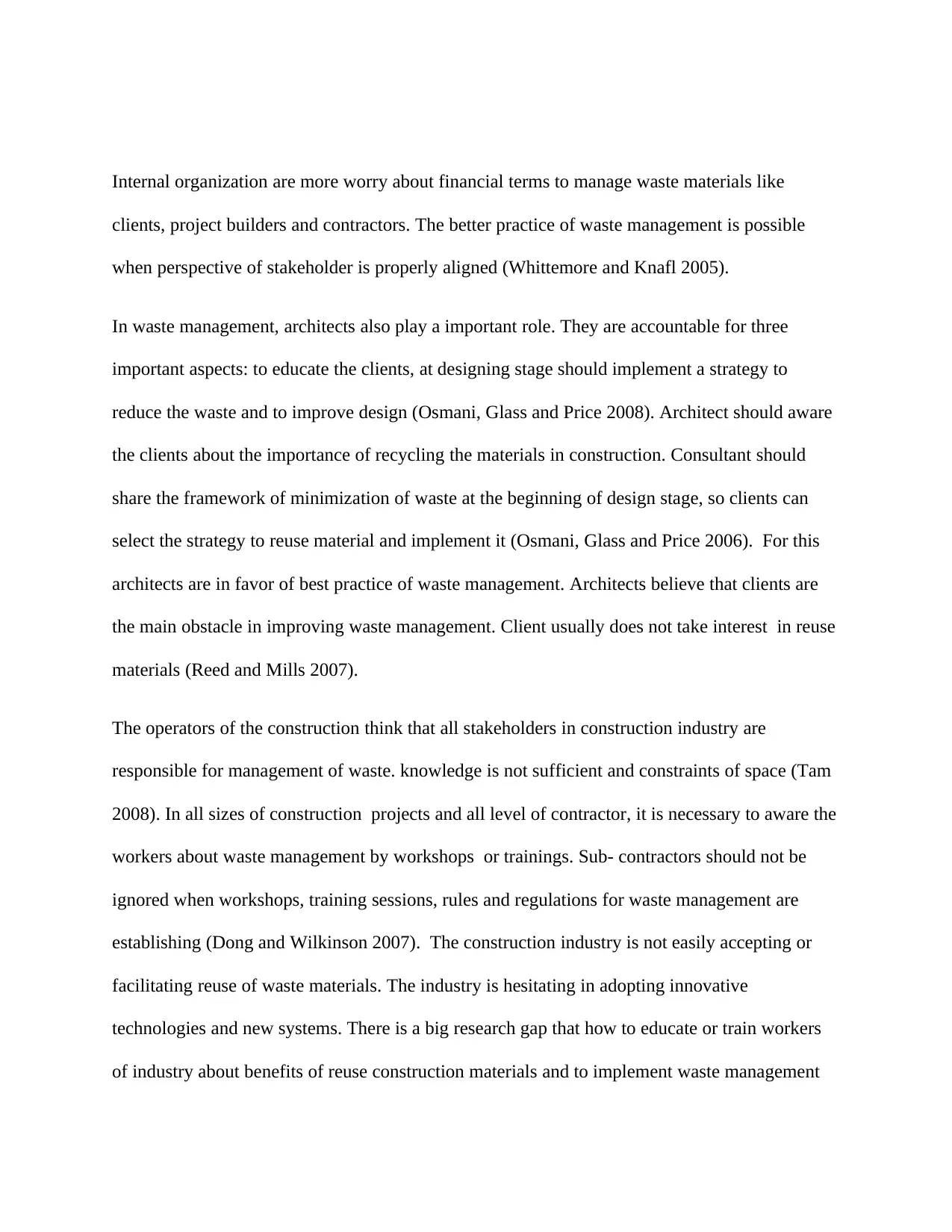
Internal organization are more worry about financial terms to manage waste materials like
clients, project builders and contractors. The better practice of waste management is possible
when perspective of stakeholder is properly aligned (Whittemore and Knafl 2005).
In waste management, architects also play a important role. They are accountable for three
important aspects: to educate the clients, at designing stage should implement a strategy to
reduce the waste and to improve design (Osmani, Glass and Price 2008). Architect should aware
the clients about the importance of recycling the materials in construction. Consultant should
share the framework of minimization of waste at the beginning of design stage, so clients can
select the strategy to reuse material and implement it (Osmani, Glass and Price 2006). For this
architects are in favor of best practice of waste management. Architects believe that clients are
the main obstacle in improving waste management. Client usually does not take interest in reuse
materials (Reed and Mills 2007).
The operators of the construction think that all stakeholders in construction industry are
responsible for management of waste. knowledge is not sufficient and constraints of space (Tam
2008). In all sizes of construction projects and all level of contractor, it is necessary to aware the
workers about waste management by workshops or trainings. Sub- contractors should not be
ignored when workshops, training sessions, rules and regulations for waste management are
establishing (Dong and Wilkinson 2007). The construction industry is not easily accepting or
facilitating reuse of waste materials. The industry is hesitating in adopting innovative
technologies and new systems. There is a big research gap that how to educate or train workers
of industry about benefits of reuse construction materials and to implement waste management
clients, project builders and contractors. The better practice of waste management is possible
when perspective of stakeholder is properly aligned (Whittemore and Knafl 2005).
In waste management, architects also play a important role. They are accountable for three
important aspects: to educate the clients, at designing stage should implement a strategy to
reduce the waste and to improve design (Osmani, Glass and Price 2008). Architect should aware
the clients about the importance of recycling the materials in construction. Consultant should
share the framework of minimization of waste at the beginning of design stage, so clients can
select the strategy to reuse material and implement it (Osmani, Glass and Price 2006). For this
architects are in favor of best practice of waste management. Architects believe that clients are
the main obstacle in improving waste management. Client usually does not take interest in reuse
materials (Reed and Mills 2007).
The operators of the construction think that all stakeholders in construction industry are
responsible for management of waste. knowledge is not sufficient and constraints of space (Tam
2008). In all sizes of construction projects and all level of contractor, it is necessary to aware the
workers about waste management by workshops or trainings. Sub- contractors should not be
ignored when workshops, training sessions, rules and regulations for waste management are
establishing (Dong and Wilkinson 2007). The construction industry is not easily accepting or
facilitating reuse of waste materials. The industry is hesitating in adopting innovative
technologies and new systems. There is a big research gap that how to educate or train workers
of industry about benefits of reuse construction materials and to implement waste management
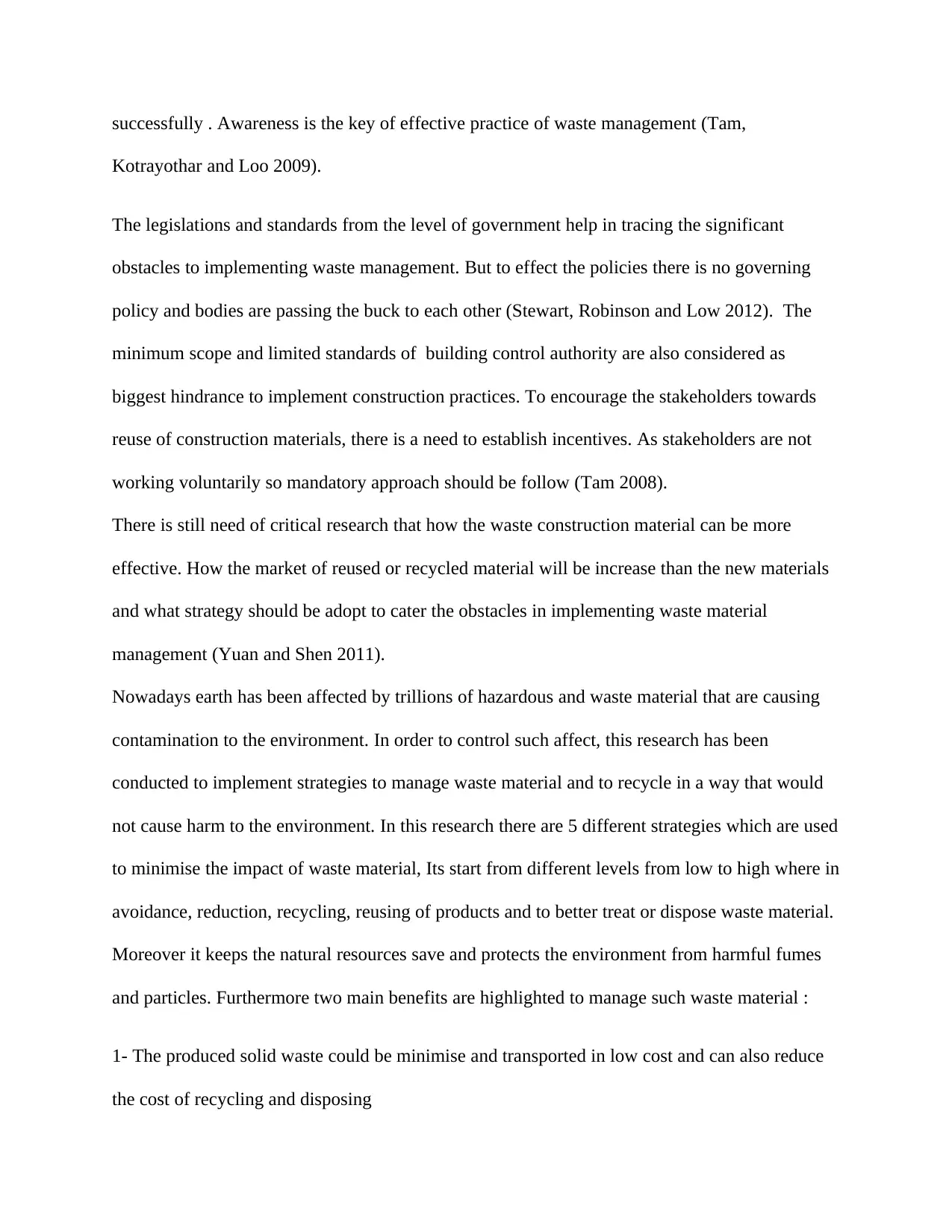
successfully . Awareness is the key of effective practice of waste management (Tam,
Kotrayothar and Loo 2009).
The legislations and standards from the level of government help in tracing the significant
obstacles to implementing waste management. But to effect the policies there is no governing
policy and bodies are passing the buck to each other (Stewart, Robinson and Low 2012). The
minimum scope and limited standards of building control authority are also considered as
biggest hindrance to implement construction practices. To encourage the stakeholders towards
reuse of construction materials, there is a need to establish incentives. As stakeholders are not
working voluntarily so mandatory approach should be follow (Tam 2008).
There is still need of critical research that how the waste construction material can be more
effective. How the market of reused or recycled material will be increase than the new materials
and what strategy should be adopt to cater the obstacles in implementing waste material
management (Yuan and Shen 2011).
Nowadays earth has been affected by trillions of hazardous and waste material that are causing
contamination to the environment. In order to control such affect, this research has been
conducted to implement strategies to manage waste material and to recycle in a way that would
not cause harm to the environment. In this research there are 5 different strategies which are used
to minimise the impact of waste material, Its start from different levels from low to high where in
avoidance, reduction, recycling, reusing of products and to better treat or dispose waste material.
Moreover it keeps the natural resources save and protects the environment from harmful fumes
and particles. Furthermore two main benefits are highlighted to manage such waste material :
1- The produced solid waste could be minimise and transported in low cost and can also reduce
the cost of recycling and disposing
Kotrayothar and Loo 2009).
The legislations and standards from the level of government help in tracing the significant
obstacles to implementing waste management. But to effect the policies there is no governing
policy and bodies are passing the buck to each other (Stewart, Robinson and Low 2012). The
minimum scope and limited standards of building control authority are also considered as
biggest hindrance to implement construction practices. To encourage the stakeholders towards
reuse of construction materials, there is a need to establish incentives. As stakeholders are not
working voluntarily so mandatory approach should be follow (Tam 2008).
There is still need of critical research that how the waste construction material can be more
effective. How the market of reused or recycled material will be increase than the new materials
and what strategy should be adopt to cater the obstacles in implementing waste material
management (Yuan and Shen 2011).
Nowadays earth has been affected by trillions of hazardous and waste material that are causing
contamination to the environment. In order to control such affect, this research has been
conducted to implement strategies to manage waste material and to recycle in a way that would
not cause harm to the environment. In this research there are 5 different strategies which are used
to minimise the impact of waste material, Its start from different levels from low to high where in
avoidance, reduction, recycling, reusing of products and to better treat or dispose waste material.
Moreover it keeps the natural resources save and protects the environment from harmful fumes
and particles. Furthermore two main benefits are highlighted to manage such waste material :
1- The produced solid waste could be minimise and transported in low cost and can also reduce
the cost of recycling and disposing
Secure Best Marks with AI Grader
Need help grading? Try our AI Grader for instant feedback on your assignments.
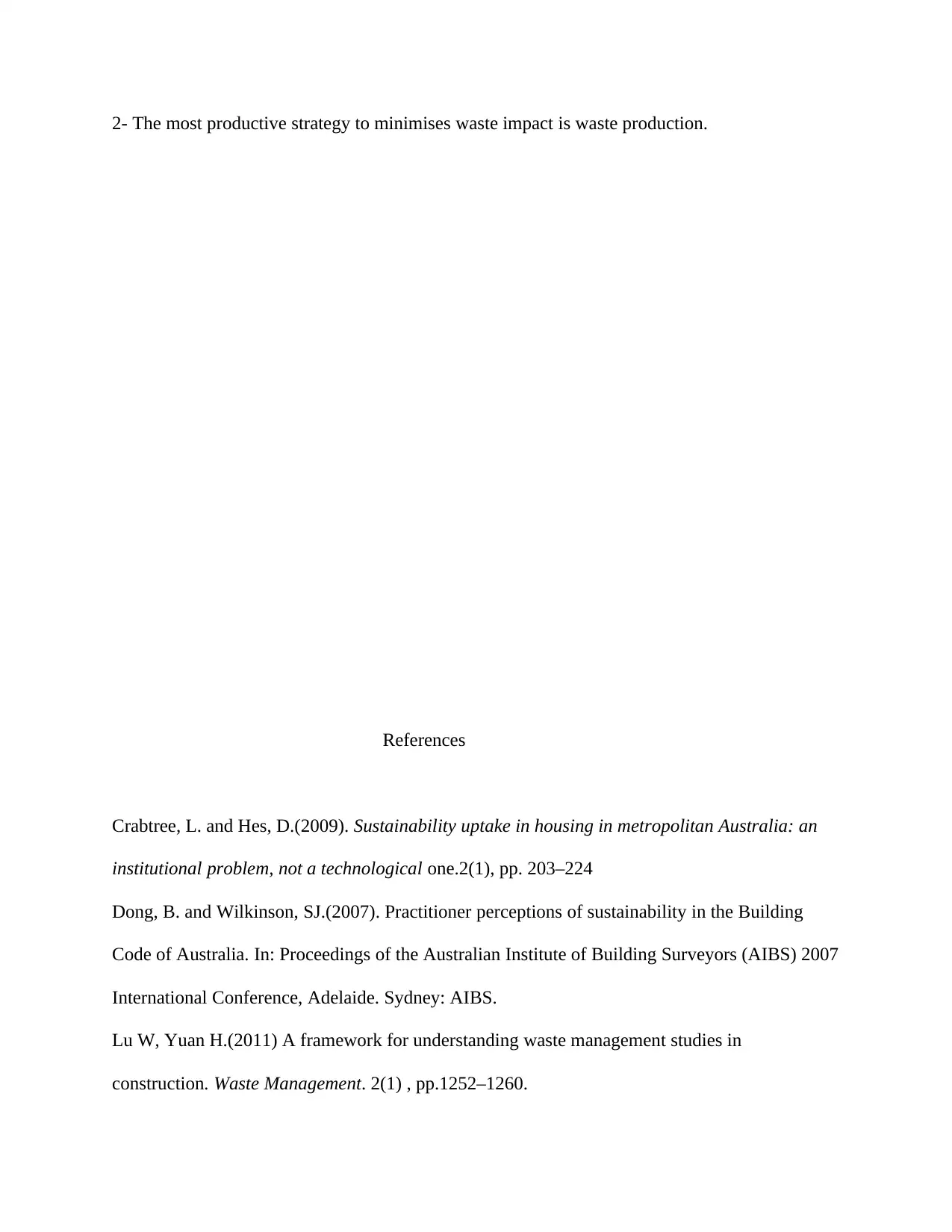
2- The most productive strategy to minimises waste impact is waste production.
References
Crabtree, L. and Hes, D.(2009). Sustainability uptake in housing in metropolitan Australia: an
institutional problem, not a technological one.2(1), pp. 203‒224
Dong, B. and Wilkinson, SJ.(2007). Practitioner perceptions of sustainability in the Building
Code of Australia. In: Proceedings of the Australian Institute of Building Surveyors (AIBS) 2007
International Conference, Adelaide. Sydney: AIBS.
Lu W, Yuan H.(2011) A framework for understanding waste management studies in
construction. Waste Management. 2(1) , pp.1252‒1260.
References
Crabtree, L. and Hes, D.(2009). Sustainability uptake in housing in metropolitan Australia: an
institutional problem, not a technological one.2(1), pp. 203‒224
Dong, B. and Wilkinson, SJ.(2007). Practitioner perceptions of sustainability in the Building
Code of Australia. In: Proceedings of the Australian Institute of Building Surveyors (AIBS) 2007
International Conference, Adelaide. Sydney: AIBS.
Lu W, Yuan H.(2011) A framework for understanding waste management studies in
construction. Waste Management. 2(1) , pp.1252‒1260.
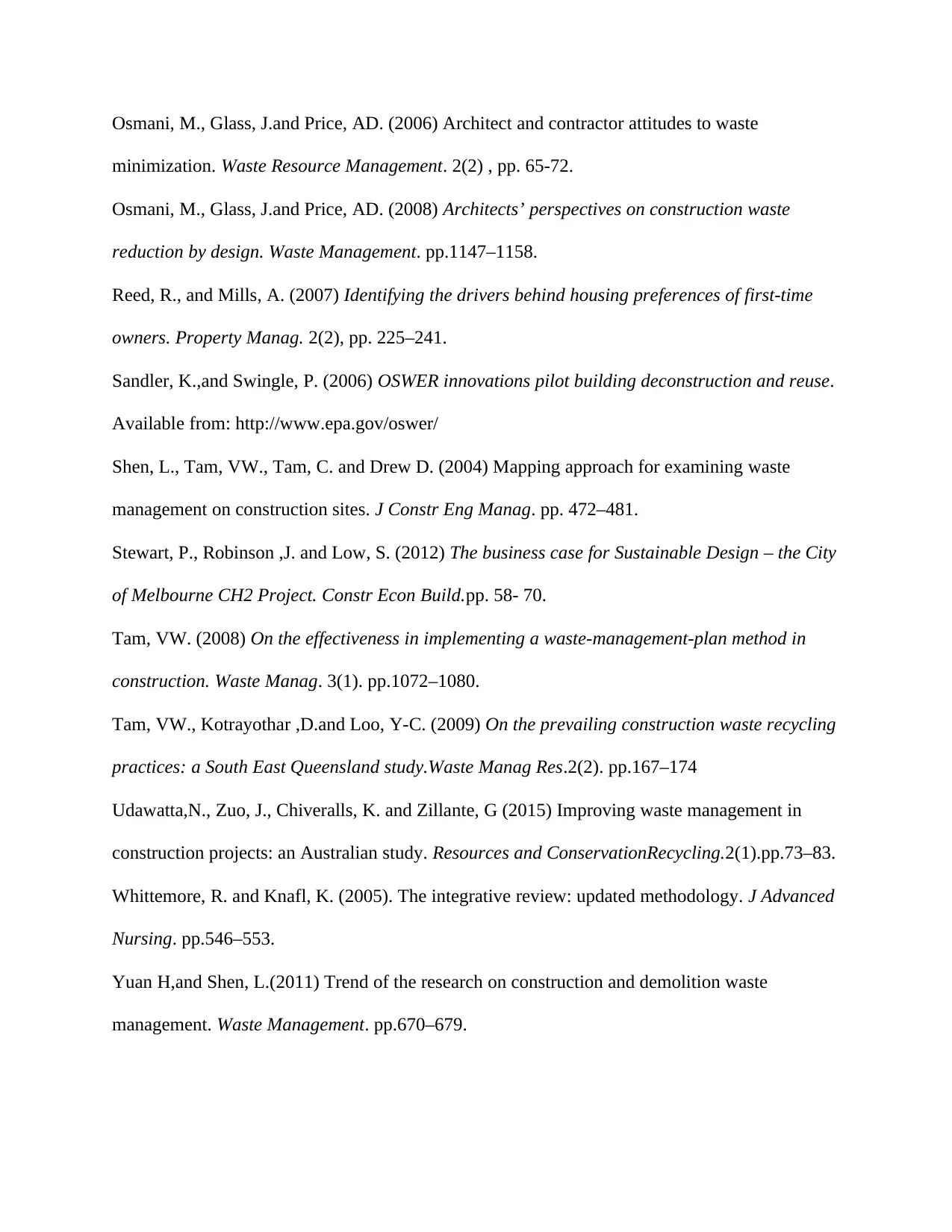
Osmani, M., Glass, J.and Price, AD. (2006) Architect and contractor attitudes to waste
minimization. Waste Resource Management. 2(2) , pp. 65-72.
Osmani, M., Glass, J.and Price, AD. (2008) Architects’ perspectives on construction waste
reduction by design. Waste Management. pp.1147‒1158.
Reed, R., and Mills, A. (2007) Identifying the drivers behind housing preferences of first-time
owners. Property Manag. 2(2), pp. 225‒241.
Sandler, K.,and Swingle, P. (2006) OSWER innovations pilot building deconstruction and reuse.
Available from: http://www.epa.gov/oswer/
Shen, L., Tam, VW., Tam, C. and Drew D. (2004) Mapping approach for examining waste
management on construction sites. J Constr Eng Manag. pp. 472‒481.
Stewart, P., Robinson ,J. and Low, S. (2012) The business case for Sustainable Design ‒ the City
of Melbourne CH2 Project. Constr Econ Build.pp. 58- 70.
Tam, VW. (2008) On the effectiveness in implementing a waste-management-plan method in
construction. Waste Manag. 3(1). pp.1072‒1080.
Tam, VW., Kotrayothar ,D.and Loo, Y-C. (2009) On the prevailing construction waste recycling
practices: a South East Queensland study.Waste Manag Res.2(2). pp.167‒174
Udawatta,N., Zuo, J., Chiveralls, K. and Zillante, G (2015) Improving waste management in
construction projects: an Australian study. Resources and ConservationRecycling.2(1).pp.73‒83.
Whittemore, R. and Knafl, K. (2005). The integrative review: updated methodology. J Advanced
Nursing. pp.546‒553.
Yuan H,and Shen, L.(2011) Trend of the research on construction and demolition waste
management. Waste Management. pp.670‒679.
minimization. Waste Resource Management. 2(2) , pp. 65-72.
Osmani, M., Glass, J.and Price, AD. (2008) Architects’ perspectives on construction waste
reduction by design. Waste Management. pp.1147‒1158.
Reed, R., and Mills, A. (2007) Identifying the drivers behind housing preferences of first-time
owners. Property Manag. 2(2), pp. 225‒241.
Sandler, K.,and Swingle, P. (2006) OSWER innovations pilot building deconstruction and reuse.
Available from: http://www.epa.gov/oswer/
Shen, L., Tam, VW., Tam, C. and Drew D. (2004) Mapping approach for examining waste
management on construction sites. J Constr Eng Manag. pp. 472‒481.
Stewart, P., Robinson ,J. and Low, S. (2012) The business case for Sustainable Design ‒ the City
of Melbourne CH2 Project. Constr Econ Build.pp. 58- 70.
Tam, VW. (2008) On the effectiveness in implementing a waste-management-plan method in
construction. Waste Manag. 3(1). pp.1072‒1080.
Tam, VW., Kotrayothar ,D.and Loo, Y-C. (2009) On the prevailing construction waste recycling
practices: a South East Queensland study.Waste Manag Res.2(2). pp.167‒174
Udawatta,N., Zuo, J., Chiveralls, K. and Zillante, G (2015) Improving waste management in
construction projects: an Australian study. Resources and ConservationRecycling.2(1).pp.73‒83.
Whittemore, R. and Knafl, K. (2005). The integrative review: updated methodology. J Advanced
Nursing. pp.546‒553.
Yuan H,and Shen, L.(2011) Trend of the research on construction and demolition waste
management. Waste Management. pp.670‒679.

1 out of 7
Related Documents
Your All-in-One AI-Powered Toolkit for Academic Success.
+13062052269
info@desklib.com
Available 24*7 on WhatsApp / Email
![[object Object]](/_next/static/media/star-bottom.7253800d.svg)
Unlock your academic potential
© 2024 | Zucol Services PVT LTD | All rights reserved.




